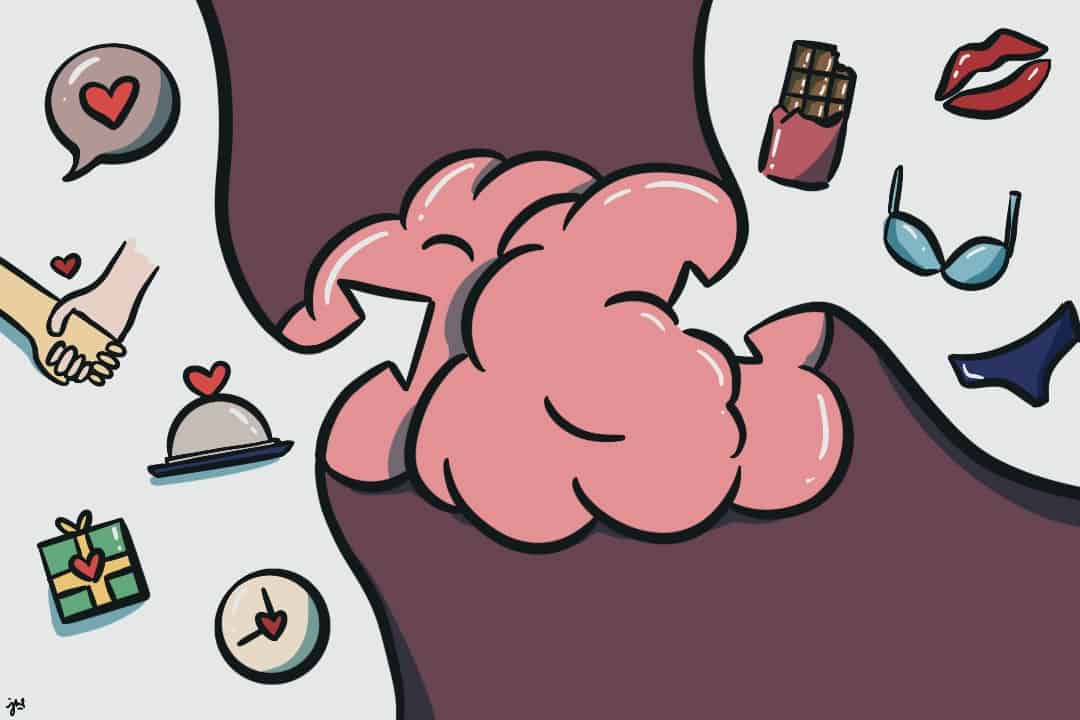Think of the last time you had a crush — palms all sweaty, eyes flickering, heart beating out of your chest. For the longest time, people thought that the heart was behind all of this, but as it turns out, the brain was the mastermind controlling the sensation of love.
To understand this, we can break down romantic love into categories: lust, attraction, and attachment. Scientists believe that different chemicals control these categories in your brain. Testosterone, estrogen, dopamine, and norepinephrine control lust and attraction, while oxytocin, vasopressin, dopamine, and serotonin control the feeling of love.
But what is lust? It’s not just one of the seven deadly sins, is it? Lust is thought to be driven by sexual gratification and is often attributed to the evolutionary need to reproduce.
Naturally, rewarding and pleasurable activities are vital to the human experience and survival. Activities such as sex rely on the brain’s reward circuitry. The main chemical behind the circuitry is dopamine, the ‘pleasure’ neurotransmitter, and some endorphin activity, also known as the body’s natural morphine.
These chemicals drive the desire for lust and keep you returning to that one person. Dopamine, released by your hypothalamus — the hormone control center of your brain — creates the feeling of euphoria and the ‘feel good’ state. The entire reward circuit, including the hypothalamus, also becomes activated when a person takes opioids!
Now, let’s get physical about love.
What does it feel like? People in love often describe love as feeling secure, safe, light, and airy. Like wanting a hug and being hugged all the time. It feels habitual, natural, and warm, but still exciting.
And all of this is due to a chemical called oxytocin. Oxytocin is often known as the cuddle hormone and the chemical of love. It drives behaviours such as trust and social cooperativity. It’s the chemical that spurs the bond between a mother and her child, and even orgasms. Even shaking hands or hugging a person can release oxytocin in our brains.
It is a powerful hormone, and researchers have found that it is actually an “amplifier” hormone, meaning that whatever strong emotion we are feeling at a specific moment, it amplifies that. When it comes to the feeling of love, it strengthens trust, feeling of security, and bonding. Both oxytocin and vasopressin — a hormone controlling blood pressure — have also been found to “deactivate” the regions of the brain associated with negative emotions, social judgment, and assessment of others’ intentions and emotions.
I guess that is why people say love makes you blind!
Interestingly, the reward system also plays a role in love. Some areas of the brain that are involved in love are the medial insula; anterior cingulate; hippocampus; and, in the subcortex, parts of the striatum and probably also the nucleus accumbens, which together make up the reward system. This system provides that euphoric feeling using dopamine signalling, which keeps your attachment to your partner intact.
Human attachment also employs a push-pull mechanism that overcomes this social distance by deactivating the networks used for critical social assessment and assessing their intentions and negative emotions while bonding you and your partner through the involvement of the reward system.
All of this is to say that the power of love is apparent. It takes over our social interactions and cognitive circuitry and even affects a lot of the decisions we make daily! It is the biggest motivator and exhilarator of the human experience — dare I say, even more potent than lust? Nonetheless, these emotions, experiences, or whatever you might want to call them, are complex in their neurobiology and have ups and downs. But they might be one of the most significant factors why the human race has survived for as long as it did!
As we learn more about the mechanisms and neurobiology of love and lust, it becomes increasingly clear how so many human interactions rely on these feelings and why understanding them can be key to understanding human behaviour.


